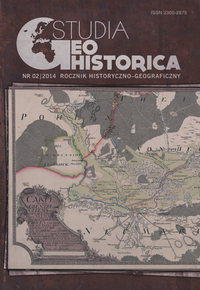Wizja korytarza czesko-rosyjskiego według polskich map z 1920 roku
A vision of the Czech-Russian corridor according to Polish maps from 1920
Author(s): Piotr EberhardtSubject(s): Historical Geography
Published by: Polskie Towarzystwo Historyczne
Keywords: geografia historyczna;geopolityka;korytarz czesko-rosyjski;historical geography;geopolitics;Czech-Russian corridor
Summary/Abstract: The article analyzes the content of the book which was published in Warsaw at the beginning of 1920. It was devoted to the possibilities of realization of a territorial corridor between Germany and Russia and the potential consequences of its creation. The idea appeared after the decisions taken at the Paris Peace Conference signed in Versailles (28 June 1919), but before the decisions of the Entente powers in Trianon (4 June 1920), which set the political borders of Hungary. In that situation it was not yet known whether Poland would border with Hungary in the south or with Czechoslovakia. Th e aforementioned publication collected 33 articles related to that uncertainty. They appeared at the turn of 1919 and 1920 on the pages of Polish periodicals. They were concerned with geopolitical repercussions that the decisions of the great powers had for Poland regarding the course of the borderline on the southern side of the Carpathian Mountains. Two potential scenarios of events were considered. They were presented on two maps, which constitute an integral part of the present article. The first variant assumed including the Slovak and Ruthenian lands into Czechia. Th e other maintained the existing political structure, together with the common Polish-Hungarian border. Th e first variant provided for the possibility of creating a territorial corridor connecting Germany with Russia and running through the territories of Czechoslovakia and Ukraine. Th e authors opted for the second solution, which was supposed to be much more beneficial for Poland. They justified it with military, political and economic reasons. Th e near future showed that neither of those two variants was realized since Hungary lost the Slovak and Ruthenian lands, and the corridor between Soviet Russia and Czechoslovakia was blocked by the territories of Poland and Romania. Despite that missed project, the publication under discussion is of great historical value and it is a significant achievement of the Polish geopolitical thought.
Journal: Studia Geohistorica
- Issue Year: 2014
- Issue No: 2
- Page Range: 99-106
- Page Count: 8
- Language: Polish

